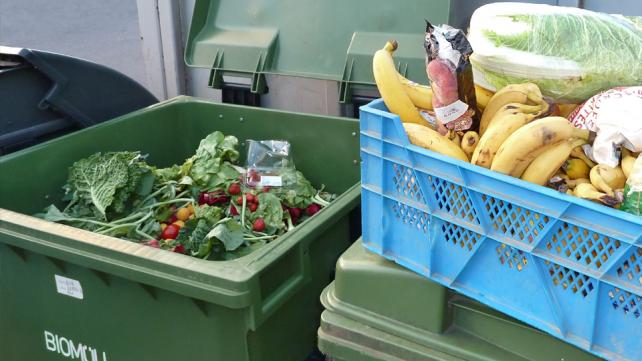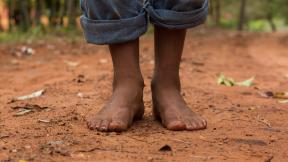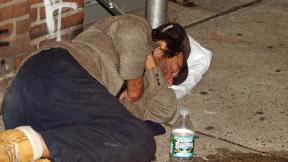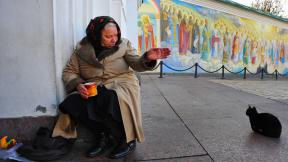
Poverty in America? One of the richest countries in the world?
Yes, poverty is a reality in America, just as it is for millions of other human beings on the planet. According to the US Census Bureau, 35.9 million people live below the poverty line in America, including 12.9 million children.
This is despite abundance of food resources. Almost 100 billion pounds of food is wasted in America each year. 700 million hungry human beings in different parts of the world would have gladly accepted this food.
Here are some statistics on the nature of poverty and the waste of food and money in America.
-In 2004, requests for emergency food assistance increased by an average of 14 percent during the year, according to a 27-city study by the United States Conference of Mayors.
-Also in this study, it was noted that on average, 20 percent of requests for emergency food assistance have gone unmet in 2004.
-According to the Bread for the World Institute 3.5 percent of U.S. households experience hunger. Some people in these households frequently skip meals or eat too little, sometimes going without food for a whole day. 9.6 million people, including 3 million children, live in these homes.
-America's Second Harvest (http://www.secondharvest.org/), the nation's largest network of food banks, reports that 23.3 million people turned to the agencies they serve in 2001, an increase of over 2 million since 1997. Forty percent were from working families.
33 million Americans continue to live in households that did not have an adequate supply of food. Nearly one-third of these households contain adults or children who went hungry at some point in 2000.
U.S. Dept. of Agriculture, March 2002, "Household Food Security in the United States, 2000"
Wasted food in America
-According to America’s Second Harvest, over 41 billion pounds of food have been wasted this year.
-According to a 2004 study from the University of Arizona (UA) in Tucson, on average, American households waste 14 percent of their food purchases.
Fifteen percent of that includes products still within their expiration date but never opened. Timothy Jones, an anthropologist at the UA Bureau of Applied Research in Anthropology who led the study, estimates an average family of four currently tosses out $590 per year, just in meat, fruits, vegetables and grain products.
Nationwide, Jones says, household food waste alone adds up to $43 billion, making it a serious economic problem.
- Official surveys indicate that every year more than 350 billion pounds of edible food is available for human consumption in the United States. Of that total, nearly 100 billion pounds - including fresh vegetables, fruits, milk, and grain products - are lost to waste by retailers, restaurants, and consumers.
-“U.S.-Massive Food Waste & Hunger Side by Side” by Haider Rizvi
-According to a 1997 study by US Department of Agriculture's Economic Research Service (ERS) entitled "Estimating and Addressing America's Food Losses", about 96 billion pounds of food, or more than a quarter of the 356 billion pounds of edible food available for human consumption in the United States, was lost to human use by food retailers, consumers, and foodservice establishments in 1995.
Fresh fruits and vegetables, fluid milk, grain products, and sweeteners (mostly sugar and high-fructose corn syrup) accounted for two-thirds of the losses. 16 billion pounds of milk and 14 billion pounds of grain products are also included in this loss.
Food that could have gone to millions
According to the US Department of Agriculture, up to one-fifth of America's food goes to waste each year, with an estimated 130 pounds of food per person ending up in landfills. The annual value of this lost food is estimated at around $31 billion But the real story is that roughly 49 million people could have been fed by those lost resources. (For your persona jihad against wastage, see A Citizen's Guide to Food Recovery
(The figures below are 1998 figures)
- Proportion of Americans living below the poverty level: 12.7 percent (34.5 million people)
- The average poverty threshold for a family of four: $16,660 in annual income
- The average poverty threshold for a family ofthree: $13,003 in annual income
- Poverty rate for metropolitan areas: 12.3 percent
- Poverty rate forthose living inside central cities: 18.5 percent
- Poverty rate for those living in the suburbs: 8.7 percent
- Percentage and number of poor children: 18.9 percent (13.5 million)
- Children make up 39 percent of the poor and 26 percent of the total population.
- The poverty rate for children is higher than for any other age group.
Child poverty:
- -for children under age 6 living in families with a female householder and no husband present: 54.8 percent
- -for children under age 6 in married-couple families: 10.1 percent
- Poverty rate for African Americans: 26.1 percent
- Poverty rate for Asians and Pacific Islanders: 12.5 percent
- Poverty rate for Hispanics of any race: 25.6 percent
- Poverty rate fornon-Hispanic whites: 8.2 percent
Photo Attribution: http://commons.wikimedia.org/wiki/File:Recovering_wasted_food.JPG








Comments
15% of American's are poor.99% of American's own a TV.
Location
Hello there,My name is Emily Conwell, a Social Media Specialist for several earnings sites at Adworkz, Inc. a company based out of Spokane, Wash. Because of the industry you are in, we wanted to reach out and offer a free sidebar app that, through our own studies, has been proven to be very effective in entertaining visitors and increasing site exposure and popularity.See how it looks and works on our site: Visit http://tools.personalmoneystore.com/percent-of-populations-earning-under... to see how this sidebar looks, and works. It can be personalized with your sites colors and topics as well. These widgets are great for keeping constant up-to-date information flowing in and keeping your viewers well informed.Here's an example of how it can help:Having this easy to understand widget helps your site’s appearance and appearance of being professional.Providing additional ways for visitors to interact with and explore your content can increase the amount of time they spend on your site. This can lead to a better experience for them resulting in higher visitor return rates via bookmarking and sharing your site on social media outlets like Facebook and Twitter.You don’t have to pay for the code development which saves you as much as $500-$1000 in development costs.If you are interestedIn conclusion, if this is something you would like to incorporate into your current web strategy, you are more than welcome to make use of this sidebar widget wherever and in however way you please, entirely without charge. Here is the URL to the app/widget download and instructions page: http://tools.personalmoneystore.com/percent-of-populations-earning-under... behalf of Adworkz, we are constantly on the lookout for new ways to improve site visibility and overall online experience of the websites we promote. We are always open to new suggestions and ideas and would definitely appreciate your feedback. If you are interested in having us make a widget customized for your site for FREE please contact me directly at emilyc@adworkz.com, or call 1-888-ADWORKZ (239-6759) extension 204. We will also be offering free Android and iPhone apps to promote sites like yours in the near future. We would love to hear from you. Thank you for taking the time to review this proposal, and we anticipate the opportunity to work with you in the near future.Emily ConwellSocial Media Specialistemilyc@adworkz.comhttp://tools.personalmoneystore.com/1-888-239-6759 ex 204P.S. If you have any ideas on other types of apps and sidebar widgets you would like to use on your website, feel welcome to send us anything you like and we will see if we can accommodate your request. Widget Portfolio: http://goo.gl/xfdeg
Location
In my opinion most of the poverty issues in this country stem from peoples prejudices. The more we pre-judge others the deeper it gets. Someone who goes to Harvard choosing to treat someone with a high school education as an idiot. People who may not be book smart or do well on tests are not stupid. And people who are different aren't stupid either. If everyone treated others with the same respect they expect, maybe this country would be better off. I am a disabled individual who all my life have had hard times finding jobs. So, instead create them. People automatically look at you like you know what you're talking about, just because you are a business owner. Instead of treating you like you're less of a person just because you are in a wheelchair. Disabled doesn't mean dumb. Neither does your skin color, or your social class. Prejudice creates stigma, stigma creates fear from the people who it's aimed at. Fear creates lack of effort.
Location
I am an unemployed 52 year old. My 2 children are grown. I was laid off of my job of 9 years in 2009 and am finding there is no help for people too young for medicare and without children. I never thought I would be in poverty, but here I am. For people who think help is easy to get for people who are suddenly homeless or soon to be there, think again. I have many medical issues and cannot afford to go to the doctor or get meds for Rheumatoid Arthritis. Help is nearly impossible to get...unless you have children or are old enough for medicare. It is sad.
Location
I agree with the lady from Mexico, all we do is talk - not do.I've been without money before, and as far as I can tell the US gobbermint doesn't help a bit if that is the problem. For me it wasn't all that bad - you just look for more work and I've done that for almost four decades.Now, I've been fired and forced by my employer to be "disabled" - although I was doing a great job. This is poor - no money, no way to get money, punished if you had savings, no job, punished if you try to work, hungry and cold, hate from society at large, politicians and the media. The biggest need that we just don't think about is legal representation - it doesn't exist. What all of the "poor" articles have in common is the diffusion of responsibility - come on we are all sitting around letting the gobbermint give us money? Really? And my God, if you should have a home or a car - the hate flows like a torrent. We just don't care to think about the causes - if it isn't knocking at your door, it just doesn't exist for US citizens. My concern is not only for myself but also for our country. Can you see it yet, my comrades? Or does the flood of hate need to rise to your door?
Location
I agree with the lady from Mexico, all we do is talk - not do.I've been without money before, and as far as I can tell the US gobbermint doesn't help a bit if that is the problem. For me it wasn't all that bad - you just look for more work and I've done that for almost four decades.Now, I've been fired and forced by my employer to be "disabled" - although I was doing a great job. This is poor - no money, no way to get money, no job, no prospects for a job, hungry and cold, hate from society at large politicians and the media. The biggest need that we just don't think about is legal representation - it doesn't exist. What all of the "poor" articles have in common is the diffusion of responsibility. And my God, if you should have a home or a car - the hate flows like a torrent. We just don't care to think about the causes - if it isn't knocking at your door, it just doesn't exist for US citizens. My concern is not only for myself but also for our country. Can you see it yet, my comrades? Or does the flood of hate need to rise to your door?
Location
Read the article "nickel and dimed" by Barbara Ehrenreich. If you can comprehend her article, you'll understand poverty is not just because of the poor choices in life you make. You can be born into it and it's hard to get out of it. Even with two jobs(she went undercover to do an experiment to live in poverty) she had to move from a rented small shack to a trailer because she had no money for gas. She had no emergency fund. She couldn't afford healthy foods, all she ate was like things out of a can or unhealthy burgers and stuff from the restaurant she worked at. No matter how much she worked there is a poverty cycle and there is essentially no mobility.
Location
There is no doubt that persistent poverty fosters a much different state of mind than those who have never experienced it. However, if you have never experienced poverty you have no idea exactly how EXPENSIVE it is to be poor. With the exception of a very few localities, fruits and vegetables are extremely expensive but pasta and potatoes can be purchased in large quantities for a small amount of cash. Because of the depressed neighborhoods poor people live in, a loaf of bread or a gallon of milk can cost two or three times as much as other areas. People who live in persistent poverty know no other way to live - poverty policy is a means of changing that way of thinking. Instead of blaming it on their "lifestyle" why not work to show them another way?
Location
Poverty does exist, but the concept of poverty is high exagerated. Go to The Heritage Foundation for some eye-opening statistics about those classified in poverty in America. By the world's standards, most are middle or even upper class. Many of the "poor" in America prefer "things" over food in their budget.
Location
MY HOPE IS THAT WE STOP TAKING SO MUCH AND START GIVING BACK TO THOSE FRIENDS, NIEGHBORS THAT HAVE LOST SO MUCH.
Location
Pages
Add new comment